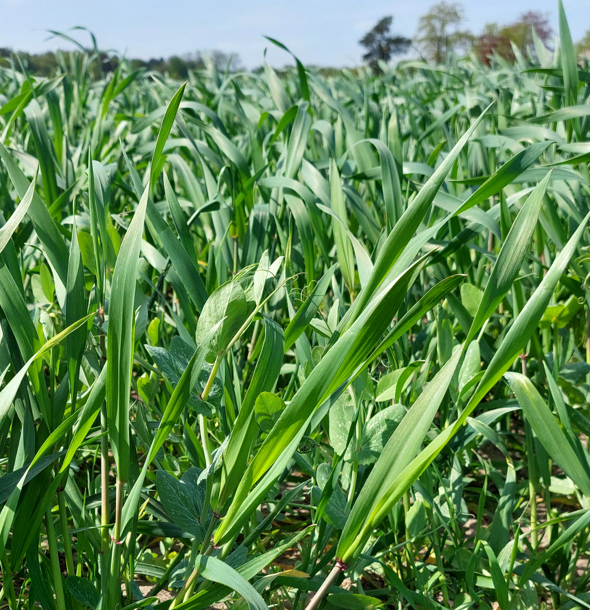Arable mixed crops
The use of mixed crops in arable systems is known as intercropping or companion cropping. The most famous example is the 3 sisters approach from USA where maize, beans and squashes are grown together providing support, fertility and mulching to each crops benefit. Growing a cereal to provide a structure for peas to grow up assists harvest. A mixture of pulses and a cereal provide nitrogen to the cereal and all mixtures show reduced disease and pest incidence due to the reduction of speed of spread.
Mixture maize-bean (Hooibeekhoeve)
Cost and benefits
Most trial work has shown an increase in production in intercropped plots of 20-30% compared with the same crops grown as monocultures: Bi-cropping spring field bean (Vicia faba) and wheat (Triticum aestivum) | Agricology (English).
There is a need to separate crops after harvest if they are sold, but can provide a complete food for livestock. There is also some evidence of increased protein content of wheat when grown with field beans: Field Lab (innovativefarmers.org) (English).
Choice of species
Relation to pest control
The presence of more than one crop can confuse insect pests by preventing easy movement within the crop, distraction by different smells and structures or by hosting beneficial competitors. Disease spread is reduced because movement of inoculum is slowed by different plants.
Reduction of weeds
Intercrops also reduce weed burden because the mixed crop covers the ground more leaving less space for weeds. Different plant structures allow more competitive ground covering.
Land covering
As well as suppressing weeds, companion crops can also be used to provide ground cover through out the year and produce nutrients for following crops such as clovers in a living mulch.
Types of mixing
In arable cropping, seeds would generally be planted together but where horticultural crops are grown, it is possible to plant rows or blocks of different species. This provides many of the benefits of intercropping but allows easier harvesting of vegetables.
Management
Sowing
Most mixtures will be sown together at one time. Where seeds need different planting depths, two passes with the drill may be necessary with deepest seeds planted first. Direct drilling techniques, or drills associated with inter row weeders can allow sequential sowing.
Harvest

More information on the management of:
- Pulses mixes with a cereal to secure pulse yield (French)
- Mixed crops for grain harvest in general (French)
- Cover crops with rapeseed (French)
- Mixed crops for grain harvest (organic farming, animal feed) (French)
Méteil mixture (Pulses and cereal) (Hooibeekhoeve)